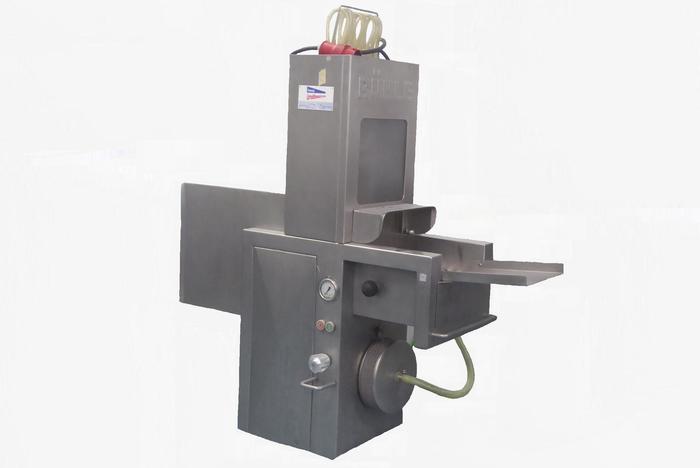Injection machine
Uses: It’s used to fill meat with brine or other liquids. It’s used to make ham, bacon, marinated loin…
Safety and cleaning: When the machine is working we shouldn’t put our hands further than the plastic curtains to avoid any accidents with the injection needles. The injection machine is detached partially for cleaning. The machine is cleaned with hot water and detergent, being especially careful when cleaning the suction tube and the brine conduct, when the machine is used. This operation is made by putting the machine to work for some time with water and detergent and putting a plastic piece under the needle so it throws out the water. It’s recommended to detach and clean the needles every now and then as brine clumps may get stuck in them blocking the way.
How it works: The first thing we have to do is prepare the brine and put it in a container where the suction tube will go. Then, we will put another container to gather the extra brine. Right after this, we will turn the machine on and we put the meat pieces on the conveyor, they will pass through the needle zone where they will be injected and they will come out from the other side where there will be another container to gather them. An important previous operation is the pressure regulation, which will depend on the product we’re making the higher the pressure is, the more the brine will be.
-
Type of dish
- Beers
- Cocktails
- Breakfasts and brunch
- Burguers
- Juices, milkshakes and beverages
- Shellfish
- Bread and pastries
- Pizzas, patty
- Dessert
- Pasta
- Sándwich
- Pastries
- Finger foods
- Ice creams and sorbets
- Legumes
- Salads
- Eggs
- Patty
- liqueur
- Harvard plate
- Main course
- Meats
- Fish
- Birds
- Vegetables
- Soups and creams
- Rices
- Coffee, chocolate and infusion
- Cheeses
- Appetizers and canapes
- Temperature
- Cuisine type
- Additional culinary preparation
- Conservation technique
- Seasonal recipes
-
- Aromatic herbs
- Beverages
- Big game hunt
- Bread and pastries
- Canned goods and pickles
- Cereals
- Condiments, spices and additives
- Cooked, salted, preserved and cold meats
- Dried fruits and nuts
- Dry pulses
- Edible oils and vinegars
- Eggs and derivatives
- Feathered game hunt
- Fish cuts
- Fishes
- Insects
- Kitchen and bakery tecniques
- Kitchen and bakery utensils
- Meat cuts
- Meats
- Milk, cream and derivatives
- Mushrooms
- Offal
- Pasta, rice, flour and derivatives
- Poultry
- Seafood
- Service techniques
- Service utensils
- Vegetables cuts
- Vegetables, fruits, tubers and seaweed

